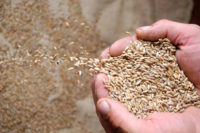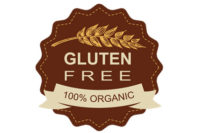It's About Time for Gluten-Free Labeling
It’s about time for gluten-free labeling, says Editor-in-Chief Lauren R. Hartman. Will the confusion that today surrounds the appropriate terminology end?

In August, the Food and Drug Administration (FDA), Washington, D.C., reviewed how to label foods as “gluten-free,” and also gave a new look at what gluten-free means. It’s about time. There are currently no standards for labeling something as gluten-free, and for many people with a gluten intolerance or who suffer from celiac disease, they must deal with a complete abstinence from gluten, which is difficult when foods that are marketed and sold as “safe” might contain gluten present in wheat, rye, oats, barley and other crossbreeds of these grains. Experts aren’t yet sure why some consumers have sensitivity to gluten instead of full-blown celiac, so the sensitive ones fall in a bit of a gray area for the time being.
Even foods that are labeled gluten-free-which means they don’t contain the substance that helps dough rise and prevents breads from falling apart-have been shown to generate harmful effects to individuals with celiac if they’re made in production facilities that also process products containing wheat or wheat gluten. These products can be labeled gluten-free and also with “manufactured in a plant containing wheat.” Remember, the only treatment for celiac is a life-long, gluten-free diet.
Eating gluten-free isn’t supposed to be a fad diet, says Rhonda Kane, a registered dietitian and consumer safety officer at FDA. “It’s a medical necessity for those who have celiac disease,” she says. “There are no nutritional advantages for a person not sensitive to gluten to be on a gluten-free diet. Those who are not sensitive to gluten have more flexibility and can choose from a greater variety of foods to achieve a balanced diet.”
According to the FDA, gluten-free isn’t synonymous with low-fat, low-sugar or low-sodium. For people who must be on a gluten-free diet, Kane says it’s critical to look at the ingredients list and nutrition facts information on food labels to find the most nutritious options.
The FDA admits that consumers “need to know whether a food contains gluten,” and the agency has been working to define gluten-free to eliminate uncertainty about how food producers may label their products. Doing so assures consumers who must avoid gluten that foods labeled gluten-free meet a clear standard established and are enforced by FDA and that the FDA’s actions on Aug. 2 bring the agency one step closer to a standard definition of gluten-free.
On that date, the FDA also reopened the public comment period on its proposed gluten-free labeling rule published on Jan. 23, 2007. It also is making available, and seeks comments on, a report on the health effects of gluten and a safety assessment on levels of gluten sensitivity in consumers with celiac disease. The FDA states that it continues to believe the proposed definition of gluten-free is the correct one, and describes current analytical methods that can reliably and consistently detect gluten at levels of 20 ppm or more in a variety of foods.
However, with so many gluten-free products on the market-tastier breads, flavorful cookies, nutritious snack bars and even appetizing pizza crusts-wording is getting more confusing. Every packager has its own way of labeling gluten-free products, which is why a definition of the term is so necessary. Now, with the first-ever government terminology on deck, the confusion can hopefully end.

In August, the Food and Drug Administration (FDA), Washington, D.C., reviewed how to label foods as “gluten-free,” and also gave a new look at what gluten-free means. It’s about time. There are currently no standards for labeling something as gluten-free, and for many people with a gluten intolerance or who suffer from celiac disease, they must deal with a complete abstinence from gluten, which is difficult when foods that are marketed and sold as “safe” might contain gluten present in wheat, rye, oats, barley and other crossbreeds of these grains. Experts aren’t yet sure why some consumers have sensitivity to gluten instead of full-blown celiac, so the sensitive ones fall in a bit of a gray area for the time being.
Even foods that are labeled gluten-free-which means they don’t contain the substance that helps dough rise and prevents breads from falling apart-have been shown to generate harmful effects to individuals with celiac if they’re made in production facilities that also process products containing wheat or wheat gluten. These products can be labeled gluten-free and also with “manufactured in a plant containing wheat.” Remember, the only treatment for celiac is a life-long, gluten-free diet.
Eating gluten-free isn’t supposed to be a fad diet, says Rhonda Kane, a registered dietitian and consumer safety officer at FDA. “It’s a medical necessity for those who have celiac disease,” she says. “There are no nutritional advantages for a person not sensitive to gluten to be on a gluten-free diet. Those who are not sensitive to gluten have more flexibility and can choose from a greater variety of foods to achieve a balanced diet.”
According to the FDA, gluten-free isn’t synonymous with low-fat, low-sugar or low-sodium. For people who must be on a gluten-free diet, Kane says it’s critical to look at the ingredients list and nutrition facts information on food labels to find the most nutritious options.
The FDA admits that consumers “need to know whether a food contains gluten,” and the agency has been working to define gluten-free to eliminate uncertainty about how food producers may label their products. Doing so assures consumers who must avoid gluten that foods labeled gluten-free meet a clear standard established and are enforced by FDA and that the FDA’s actions on Aug. 2 bring the agency one step closer to a standard definition of gluten-free.
On that date, the FDA also reopened the public comment period on its proposed gluten-free labeling rule published on Jan. 23, 2007. It also is making available, and seeks comments on, a report on the health effects of gluten and a safety assessment on levels of gluten sensitivity in consumers with celiac disease. The FDA states that it continues to believe the proposed definition of gluten-free is the correct one, and describes current analytical methods that can reliably and consistently detect gluten at levels of 20 ppm or more in a variety of foods.
However, with so many gluten-free products on the market-tastier breads, flavorful cookies, nutritious snack bars and even appetizing pizza crusts-wording is getting more confusing. Every packager has its own way of labeling gluten-free products, which is why a definition of the term is so necessary. Now, with the first-ever government terminology on deck, the confusion can hopefully end.
Looking for a reprint of this article?
From high-res PDFs to custom plaques, order your copy today!






